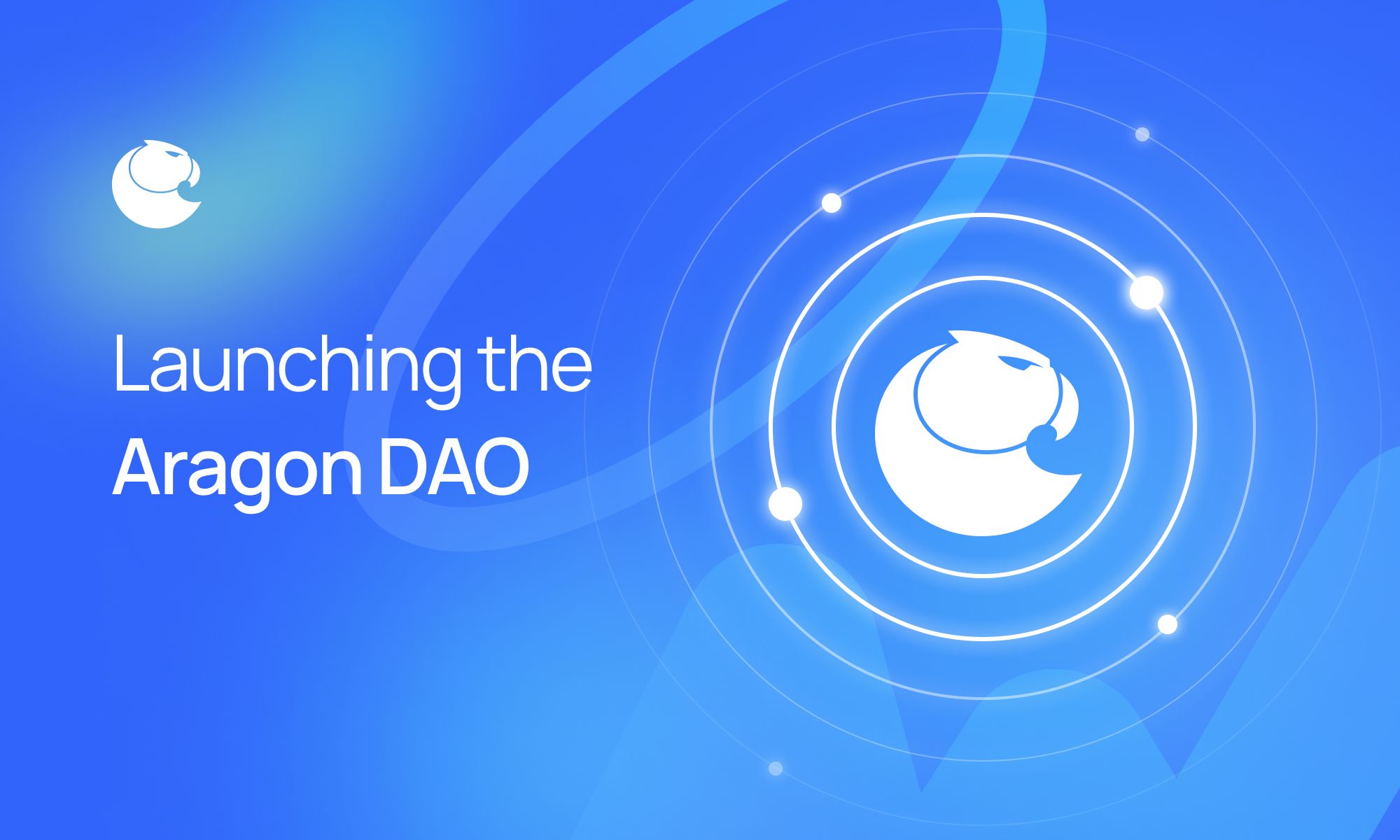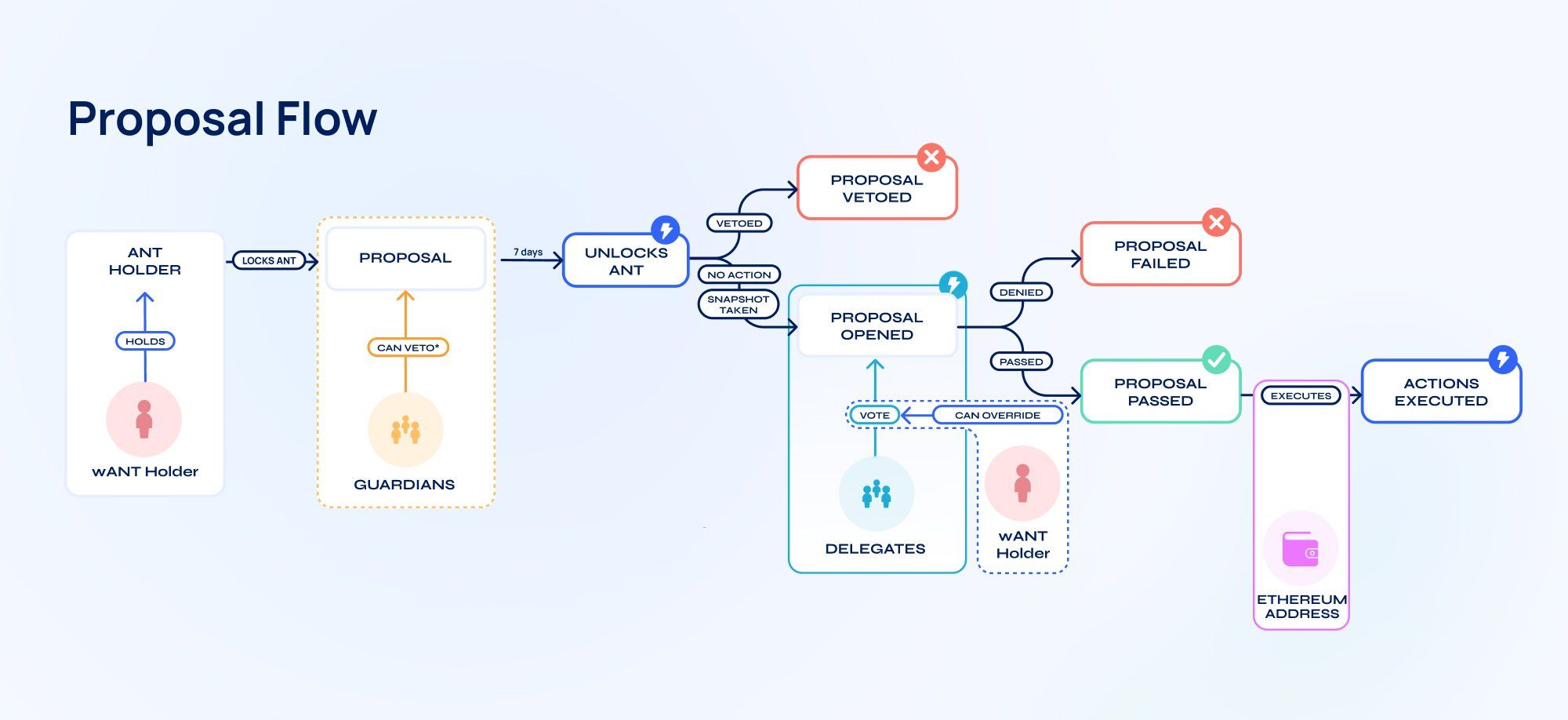Launching the Aragon DAO
How our new governance approach puts code at the center, and humans at the edges.
Aragon

Since DAOs first launched in 2016, they were always meant to put code at the center, humans at the edges. That’s the approach Aragon took with our v1 in 2016, and is the way we designed the Aragon delegated voting DAO now in 2023.
Our delegated voting DAO is lean, minimal, and simple. We don’t have a complex multi-house system or a list of social-layer technicalities to follow. Instead, we have a set of smart contracts granting governance permissions to Ethereum addresses, with human-layer guidelines and practices pushed to the edges.
This lightweight design was specifically created so we can weather uncertainty and change. With the principles of antifragility in mind, we created a DAO that ideally can survive paradigm shifts in the industry and the world. In order to create an unstoppable organization, we need to center what we know to be unstoppable: blockchain technology.
The outer edges of the organization are where the experimentation and agility will occur. This will allow us to keep up with increasing industry and geopolitical volatility. We’re relying on the human-layer—legal wrappers, delegates, guilds, developers, and DAO creators—to be agile and adaptable. We’re relying on code to be immutable and unstoppable.
Lean, adaptable, antifragile governance
When designing our governance, we knew we needed to walk a precarious line between bureaucracy and chaos. The implementation of strict social layer rules creates bureaucracy, while the absence of any rules creates chaos. Our response to walking this tightrope is to limit enforceable rules on-chain, and rely on guidelines and practices on the social layer off-chain.
Token Holders, Delegates, and Guilds can create additional legal enforcement mechanisms on the social layer if they so choose, such as joining legal wrappers and signing agreements. At the DAO level, there is no enforcement except that which can be executed on-chain.
We’ve broken down our governance into three categories: Rules, Guidelines, and Practices. You can review the full framework here.
Rules: hard-coded rules that can be enforced on-chain
Examples: Quorum, Pass rate, Vote duration, Execution timelock, ANT proposal gate, Guardians, Trusted multisig
Guidelines: standards that are generally agreed upon in shared documentation and indirectly enforced via token holder signaling or voting patterns
Examples: Strategy, Proposal framework, Delegate roles and responsibilities, Community standards
Practices: ways of working that are implemented at the guild/workstream level
Examples: Project Management, Rituals and Meetings, Hiring practices, Culture
The Rules form the core of our governance and are strictly enforced by code. The Guidelines and Practices are what inform the behavior of the humans on the edges, but don't strictly govern them. In this design, we favored incentive alignment and collaboration over social layer rules. We are applying lean startup methods to our governance, to enable us to discover what works best for our organization.
Security-as-a-process: evolving governance slowly
The Aragon DAO will be deployed with a set of smart contracts that form the default governance settings. The governance settings of the smart contracts—the permissions and parameters—are meant to evolve over time, as we experiment, learn, and build on the initial deployment.
With a new DAO comes new risks that we might not be able to plan for. So, we will not transfer our entire treasury to this DAO at once. We’ll favor a more secure approach, slowly transferring more funds on-chain over time and adjusting parameters to prioritize safety.
Before we transfer any funds on-chain we will use signalling votes followed by manually executed transactions. This will allow us to assess the level of participation in governance and inform parameter setting, such as quorum and pass rate, with data points based on experience rather than estimation.
Once we can make informed parameter adjustments, we will gradually transfer funds. This stage will serve to test the robustness of our security measures.
The treasury will be transferred gradually, as the security of our governance is tested, additional vaults are deployed, and economic incentives between ANT and the Aragon treasury align.
Let’s dive into the implementation for the initial deployment and walk through the governance flow.
The voting platform
Our delegated voting DAO is a custom solution built by the Blossom Labs team on aragonOS.
There are three components of the platform:
Token Wrapper: Where you’ll wrap your ANT. To vote, you’ll need to wrap your ANT into wANT. Wrapped tokens are not transferable. If you want to transfer your ANT, you need to unwrap it.
Delay: Execution delay. This gives Guardians time to veto or pause proposals.
TAO Voting: The delegated voting functions. This is where you delegate tokens, revoke delegation, and cast votes. Delegates can see which addresses delegated to them. You can connect to the platform with Metamask or Wallet Connect.
Basics of wANT
You must convert your ANT into wrapped ANT (wANT) to vote in the DAO. ANT must be converted to be compatible with delegated voting functionalities. You can wrap your ANT in the Token Wrapper app of the DAO platform.
The Aragon DAO is a delegated voting DAO, meaning you can delegate to another address to vote for you. However, you do not need to delegate to vote. You can simply vote without delegating.
Delegation is fluid, so you can undelegate at any time. However, when a proposal moves to vote in TAO Voting, a snapshot is taken and sets the voting power of wANT Holders and delegates for that proposal. You can always override your delegate’s vote by voting directly on the proposal.
The role of delegates is trustless and permissionless, and therefore specific behaviors cannot be explicitly enforced. wANT can be delegated to any Ethereum address, including a smart-contract owned account (ex. multisig address).
The Proposal Flow
ANT holders can create two types of proposals:
- Budgeting proposal: a proposal to signal or withdraw funds from the budget vault.
- Governance proposal: a proposal to signal or change permissions and parameters.

1. Submit your proposal: To submit a proposal, you must hold a minimum amount of ANT in your wallet, which you lock for the delay period specified in the proposal parameters.
2. Possible veto: Guardians are a security mechanism. They are not exercising subjective and opinionated oversight. They will be assigned specific tasks with limited scope (such as reviewing proposal payloads). Guardians will be appointed and removed by a trusted multisig.
3. ANT unlocked: After the delay period, your ANT is unlocked.
4. Proposal opened, starting the vote period: If your proposal is not vetoed by guardians, it can be moved to vote by any Ethereum address. Anyone who holds wANT or who is a delegate for an account holding wANT. A snapshot is taken at the beginning of the vote period, capturing the voting power of ANT Holders and Delegates. Delegates may vote on proposals on behalf of wANT Holders. wANT Holders may vote directly to override the vote of their Delegate.
5. Proposal passed and executed: If the proposal is passed, any Ethereum address can execute it within TAO Voting, sending it to mainnet execution.
Laying the groundwork for an exciting 2023
We’re excited to deploy and fully transition our team into the DAO structure. Although it is slated early for the new year, the specific timing is a moving target.
We’ll continue sharing important DAO updates at the top of our weekly newsletter, The Eagle. Sign up to keep up with the latest developments and next steps.
Subscribe to The Eagle for weekly news on the Aragon Network
